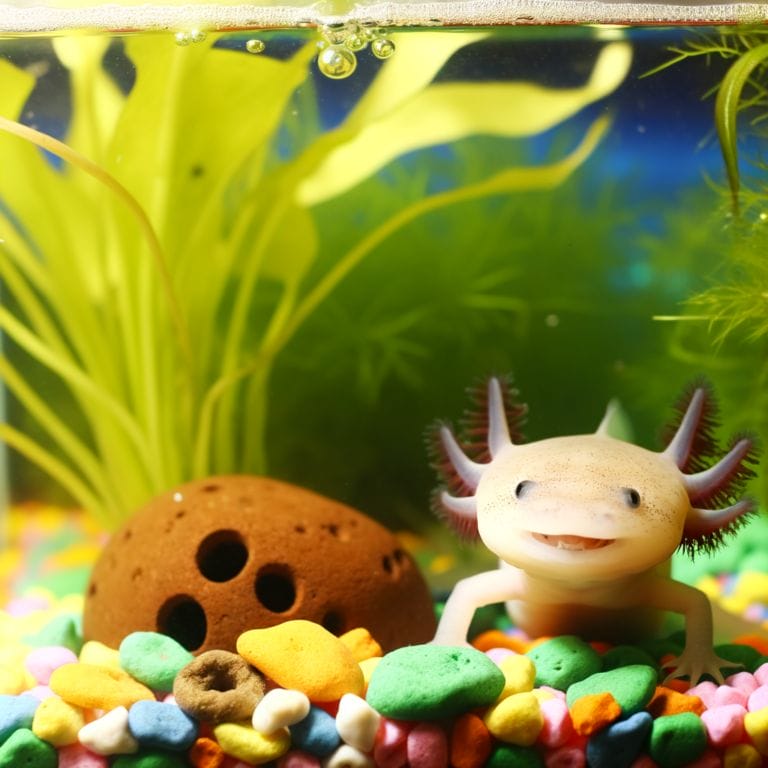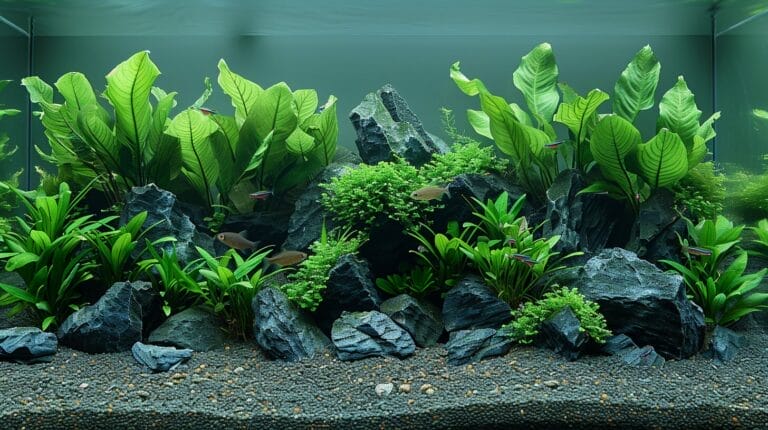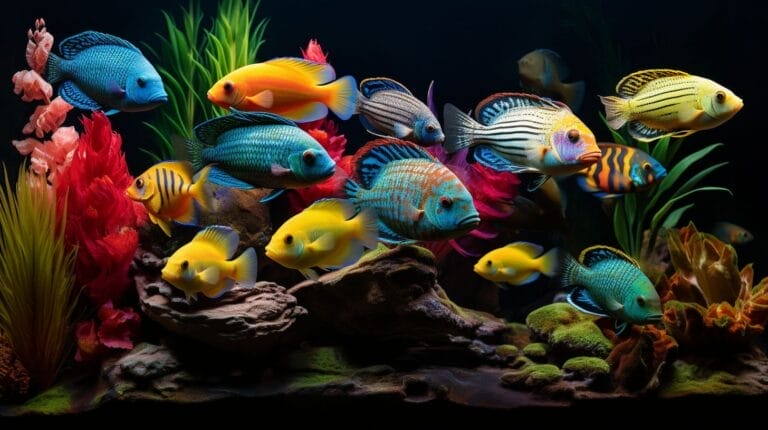Freshwater Fish Tank Setup Ideas: Aquarium Creation Mastery
So, you think setting up a freshwater fish tank is just about adding water, gravel, and fish, right?
Let’s not underestimate the art of creating a masterpiece underwater. From selecting the perfect tank size to balancing the ecosystem within, every detail matters.
Imagine transforming a simple glass box into a thriving aquatic world where every element plays a crucial role.
Stay tuned as we unravel the secrets behind crafting a freshwater aquarium that not only mesmerizes but also sustains life with precision and finesse in our Freshwater Fish Tank Setup Ideas topic.
Key Takeaways
- Tank size and location impact fish selection and maintenance needs.
- Diverse plant life and decorations create a visually appealing environment.
- Understanding the nitrogen cycle is essential for water cleanliness.
- Careful selection of fish and invertebrates ensures a harmonious tank ecosystem and keeps your fish thriving.
Choosing the Right Freshwater Fish Tank for Your Space

When selecting the perfect freshwater fish tank for your space, consider the size, location, and maintenance requirements to ensure a thriving aquatic environment. The tank size is crucial; it dictates the number and types of fish you can keep.
Smaller tanks, like nano tanks, are great for beginners or those with limited space, while larger tanks, such as 29-gallon ones, offer more flexibility in stocking options. Assess your available space to determine the right tank size that fits seamlessly into your environment.
Ensure the tank is located away from direct sunlight to prevent algae overgrowth and temperature fluctuations. Consider accessibility for maintenance tasks like water changes and filter cleaning when deciding on a suitable spot.
Introduction to the Nitrogen Cycle: The Key to a Healthy Aquarium

Understanding the nitrogen cycle is essential for maintaining a healthy aquarium ecosystem. In a fish tank, the nitrogen cycle is a natural process that helps keep the water clean and safe for your aquatic pets.
It all starts with fish waste and uneaten food, which produce ammonia. Ammonia is toxic to fish, but beneficial bacteria called nitrifying bacteria convert ammonia into nitrites, which are still harmful. Then, another type of bacteria converts nitrites into nitrates, which are less harmful and can be removed through water changes or absorbed by live plants.
To establish a nitrogen cycle in your new fish tank, kickstart the growth of beneficial bacteria by adding a bacterial supplement or using filter media from an established aquarium. Regular water checks and maintenance are crucial to ensure that the nitrogen cycle is working effectively. Test the water weekly for ammonia, nitrites, and nitrates to monitor the cycle’s progress and make adjustments as needed.
Stocking Your Freshwater Tank: Choosing the Right Fish and Invertebrates

Establishing a balanced freshwater tank involves carefully selecting the right combination of fish and invertebrates to create a harmonious ecosystem. When stocking your freshwater aquarium, consider the size of your tank. For beginners, a 20-gallon tank is a good starting point. This size allows for a variety of fish species without overwhelming the ecosystem.
For a vibrant and active tank, consider adding a school of tetras. These fish are colorful, peaceful, and thrive in groups, adding movement and life to your aquarium. When choosing fish, think about their compatibility with each other to prevent any aggression. Popular choices for beginners include cichlids, barbs, angelfish, and goldfish.
In addition to fish, invertebrates like shrimp, snails, and loaches can also be great additions to your aquarium. They help with algae control and add diversity to your tank’s ecosystem. Before adding any new fish or invertebrates, make sure to quarantine them to prevent the spread of diseases and maintain a healthy hard water environment. Also, consider the specific requirements of each species, especially when introducing bettas, mollies, or oscar fish, as they may need special care.
Planting Your Freshwater Aquarium: Creating a Natural Habitat
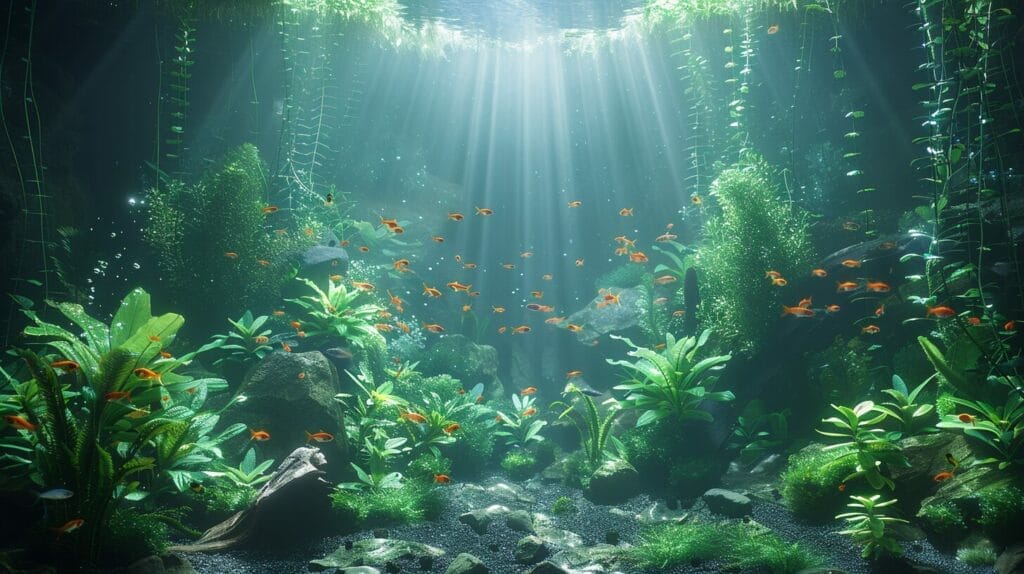
To create a natural habitat in your freshwater aquarium, consider incorporating live plants that thrive in hard water conditions. Live plants not only enhance the aesthetics of your tank but also provide oxygen, absorb nitrates, and offer hiding spots for fish, contributing to a healthy fish per gallon ratio.
When selecting plants, popular choices like java fern and anubias are excellent options due to their hardiness and low maintenance requirements, making them suitable for tropical fish tanks.
Here are some planting tips for specific fish types to create a harmonious environment:
- Java Fern: Ideal for Corydoras (Cory) Catfish
- Anubias: Great for Angelfish
- Cherry Blossom: Best for Betta Fish
How Can I Prevent Ick in My Freshwater Fish Tank Setup?
To prevent ick in your freshwater fish tank setup, there are several effective aquarium strategies you can utilize. Quarantine new fish before adding them to the tank, maintain proper water quality and temperature, and avoid overcrowding the tank. Implementing these effective aquarium strategies can help prevent ick outbreaks in your fish tank.
Freshwater Fish Tank Setup Ideas: Making Your Tank Aesthetically Pleasing
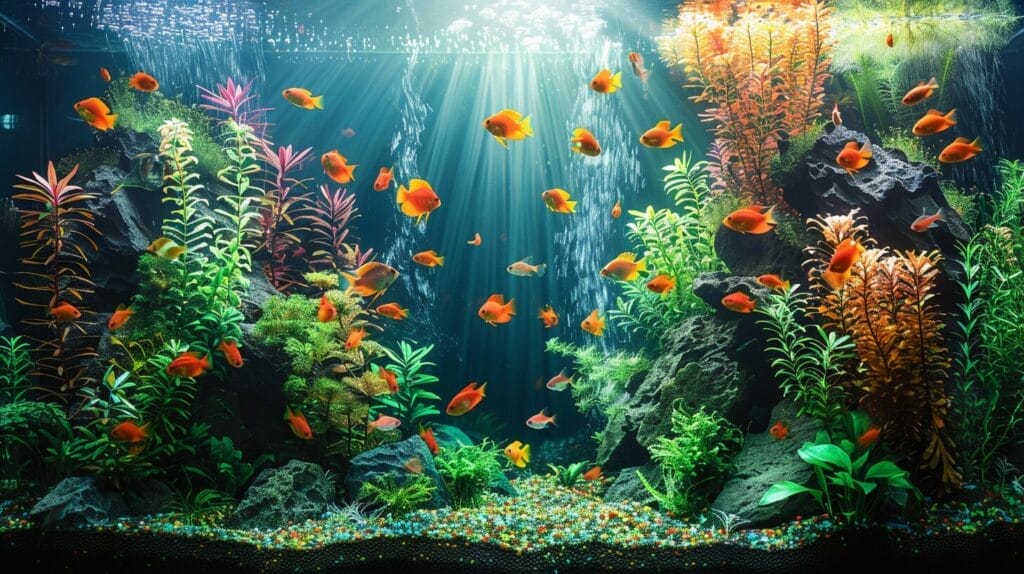
When enhancing the visual appeal of your freshwater fish tank, consider combining various elements to create a captivating and harmonious underwater environment. Here are three setup ideas to make your aquarium visually appealing:
- Diverse Plant Life: Introducing a variety of aquatic plants not only adds color and texture to your tank but also provides hiding spots and grazing areas for your freshwater fish. Consider plants like Anubias, Java Fern, or Amazon Sword for a lush and natural look.
- Decorative Elements: Enhance the aesthetic appeal of your aquarium by incorporating rocks, driftwood, or caves. These elements not only serve as decor but also create territories and shelter for your fish, promoting a healthier and more engaging environment.
- Strategic Lighting: Proper lighting can significantly impact the visual appeal of your freshwater fish tank. Experiment with different lighting options to highlight specific areas of the aquarium, showcase the colors of your fish, and simulate natural day-night cycles for a visually stunning setup.
Conclusion
Overall, creating a freshwater fish tank is a fun and rewarding experience that requires attention to detail, patience, and regular visits to the fish store for supplies and advice. From choosing the right tank size to stocking it with the perfect fish and plants, there are endless possibilities for creating a beautiful and thriving aquatic ecosystem.
By following the steps outlined in this article, including maintaining the right fish per gallon ratio, you can master the art of freshwater aquarium creation and enjoy the beauty and tranquility of your own underwater world.
Frequently Asked Questions
What are some popular freshwater fish for a new tank setup?
Some popular freshwater fish for a new tank setup include tetras, loaches, cichlids, goldfish, barbs, guppies, angelfish, mollies, and bettas.
How should I set up my first freshwater fish tank?
When setting up your first freshwater fish tank, make sure to research the specific needs of the fish you plan to keep, establish a proper filtration system, cycle the tank properly, and ensure the water parameters are suitable for your chosen fish.
What size tank is suitable for beginner fish keepers?
A 29-gallon tank is often recommended for beginner fish keepers as it provides a good balance between size and ease of maintenance.
How often should I perform maintenance on my freshwater fish tank?
It’s a good practice to perform maintenance on your freshwater fish tank every week by cleaning the glass, changing a portion of the water, and checking the equipment to ensure everything is running smoothly.
What are some key considerations when selecting fish for a new tank?
When selecting fish for a new tank, consider factors such as the size of the fish at adulthood, their compatibility with other tank mates, their water parameter requirements, and their activity level in the tank.


